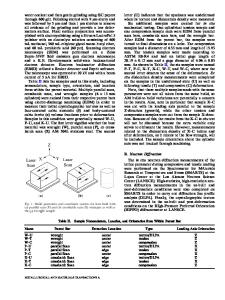Influence of Protein Structures on Mechanical Response
- PDF / 261,387 Bytes
- 6 Pages / 612 x 792 pts (letter) Page_size
- 39 Downloads / 382 Views
Y5.6.1
Influence of Protein Structures on Mechanical Response Pijush Ghosh, Dinesh R. Katti, Kalpana Katti Department of Civil Engineering, North Dakota State University Fargo, ND 58105, USA. ABSTRACT In biological nanocomposites such as bones, teeth and seashells, proteins play an important role in their mechanical response. Proteins in nacre, the inner layer of seashells have been shown to have exceptional mechanical properties. The secondary structures, βsheets of protein when present close to each other in multiple numbers could take the shape of a planar β-sheath like structure or a β-barrel to form a domain. In natural proteins both these types of structures are commonly found. Effort has been made through this work to study the mechanical response of these β-planar sheath and β-barrel structures when subjected to external loads. Comparative study of the stress-deformation characteristics of these two types of structures has been made. The influence of shear force on the conformation of planar and barrel structure is investigated. Both these structures with almost similar number of amino acids have been extracted from one single spinach protein, Ferredoxin Reductase (1FNR). Steered molecular dynamics has been used to conduct these studies. The paper deals with the separation of the two domains from the main protein, simulation details and results comparing the responses. INTRODUCTION One common type of secondary structure motifs in proteins are the β-sheets. The hydrogen bonds in β-sheets are extended from one strand to another strand forming interstrand hydrogen bonding. The directionality of the strands (N to C or C to N), their relative planar position, and the number and position of hydrogen bonds between the strands give rise to different features like twists, curls etc. which finally defines the tertiary structures of the beta domain. The β-sheets in many cases have been found to twist and coil to a very high degree of magnitude resulting in a closed barrel like structure with mainly hydrophobic core. Another commonly found tertiary structure is the planar β -sheets, where the strands are placed adjacent to each other. The sheets lie in the same plane and are tied by hydrogen bonds. Many proteins exist in nature which have domains made of either barrel structures, or planar sheets or sometimes both. Depending upon the tertiary structures of the domains, different proteins are expected to behave differently under mechanical stimulation. Attempt has been made in the past to simulate the folding and unfolding mechanism of protein under different thermodynamic conditions but so far these characteristics remain undeciphered owing to the very complex behavior of proteins in fluids. The geometrical conformation of domain(s) could have a significant influence on the overall mechanical properties of protein. The planar and barrel being the two common tertiary structures formed out of β-strands, this work focuses on these structures to evaluate mechanism and differences in mechanical responses as a result of diff
Data Loading...











